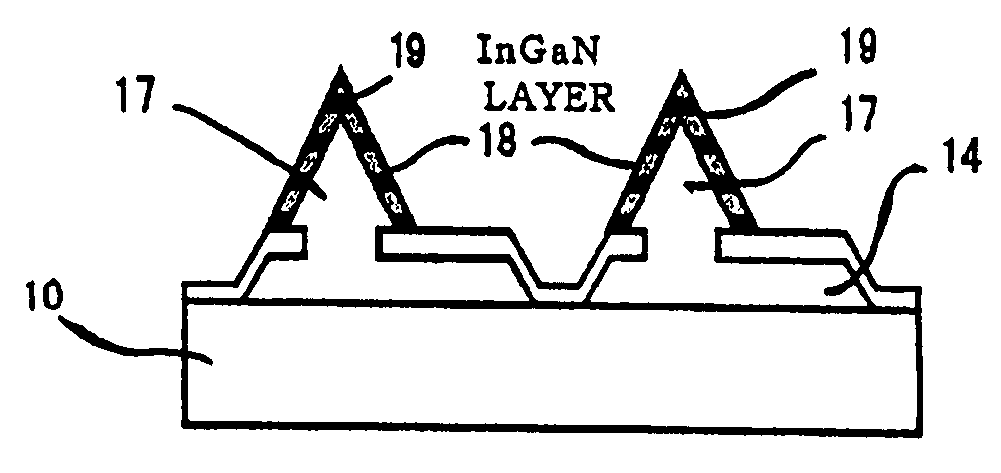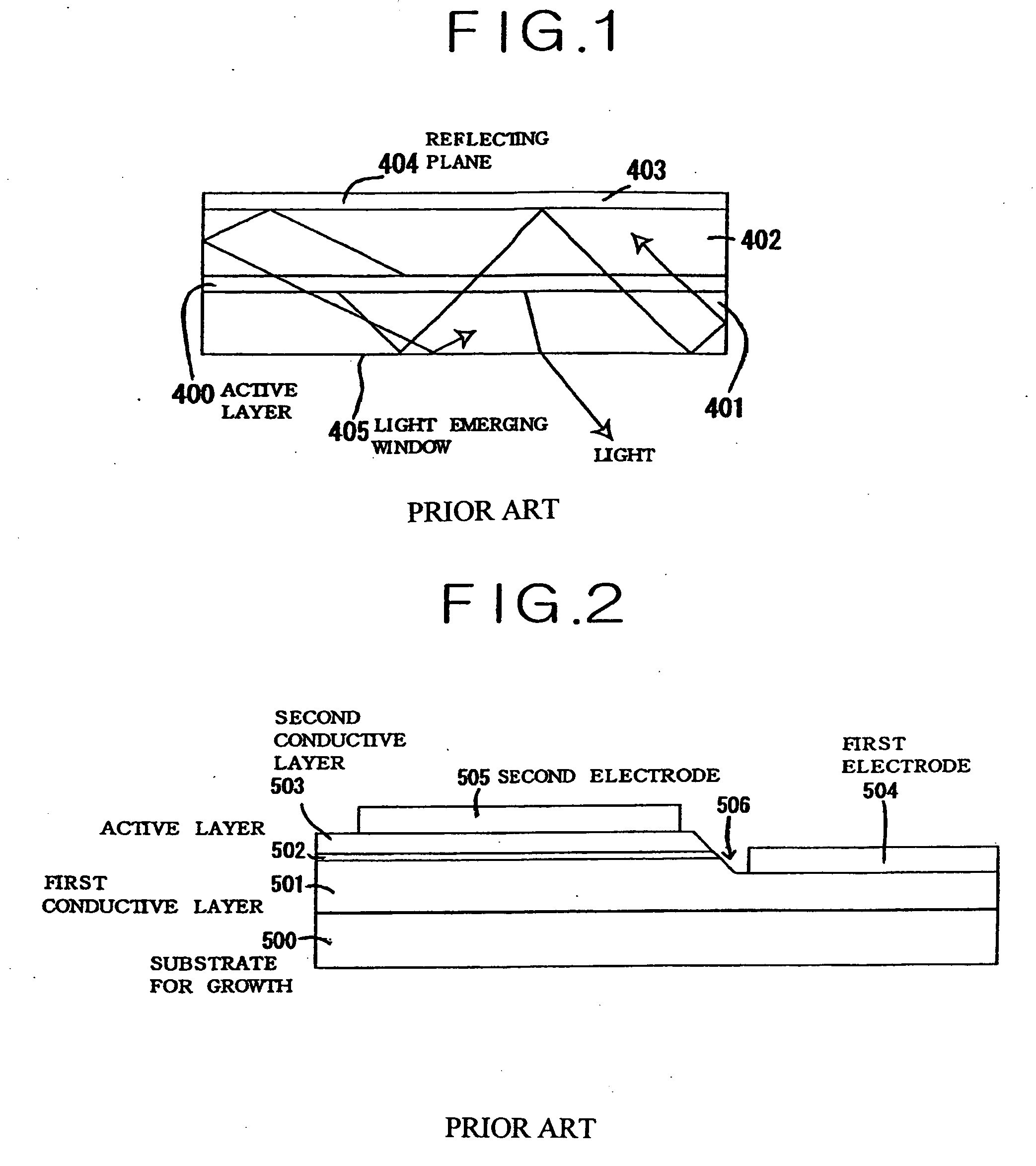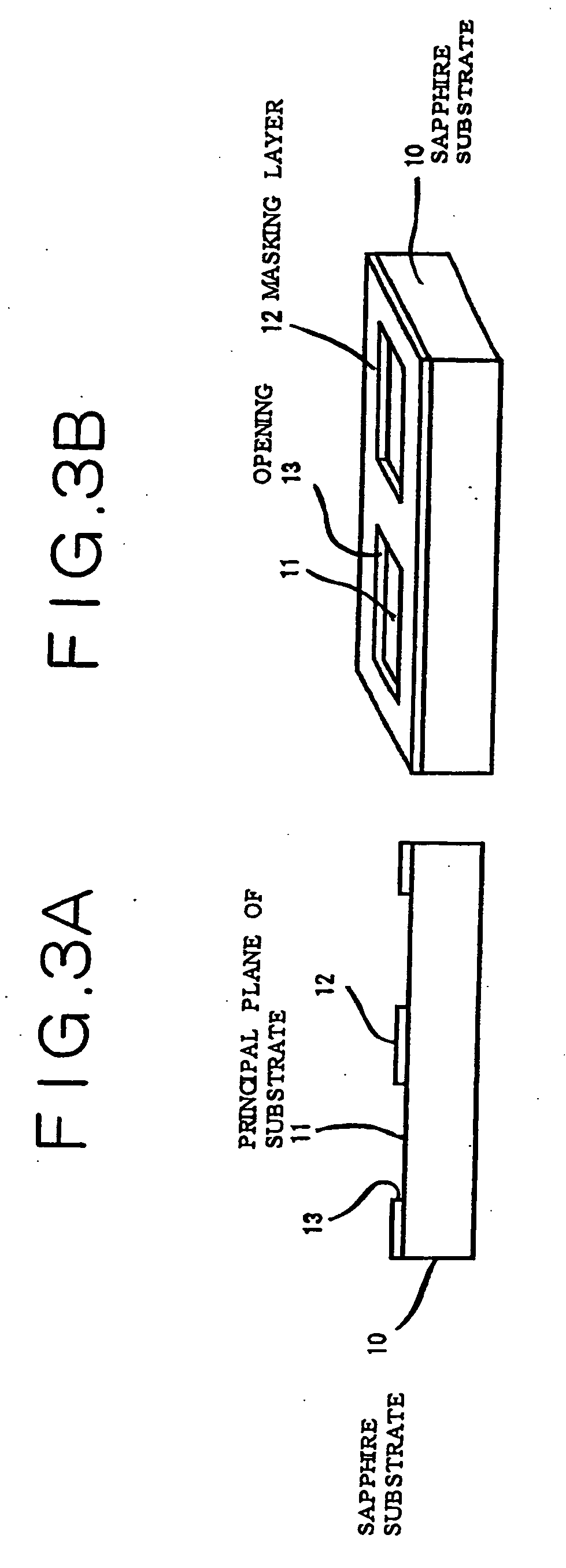Semiconductor light-emitting device and process for producing the same
- Summary
- Abstract
- Description
- Claims
- Application Information
AI Technical Summary
Benefits of technology
Problems solved by technology
Method used
Image
Examples
example 1
[0272] This example demonstrates a semiconductor light-emitting device which has a crystal layer formed by selective growth directly on a sapphire substrate. Additionally, the crystal layer includes a crystal surface having the S-plane as the slant crystal plane (i.e. the crystal surface plane that diagonally intersects the principal plane of the substrate). Its production process and structure will be described with reference to FIGS. 3A to 9.
[0273] The sapphire substrate 10 has the C+-plane as its principal plane 11 (i.e. the substrate surface plane). On the entire surface of the sapphire substrate 10 is formed the masking layer 12 (about 100 nm to about 500 nm thick) of SiO2 or SiN. In the masking layer 12 is formed the opening 13 (about 100 μm) by photolithography and etching with hydrofluoric acid based compound (see FIGS. 3A and 3B). In this Example, the opening 13 is in an approximately rectangular shape, but the size of the opening may be changed according to the characteri...
example 2
[0281] This example demonstrates a semiconductor light-emitting device which has a crystal layer (having the S-plane slanting to the principal plane of the substrate) formed on a crystal seed layer isolated from a sapphire substrate. Its production process and structure will be described with reference to FIGS. 10A to 17B.
[0282] On the sapphire substrate 30, whose principal plane is the C+-plane, is formed a buffer layer of AlN or GaN at a low temperature of about 500° C. Then, with the temperature raised to about 1000° C., the silicon-doped GaN layer 31 is formed. On the entire surface of the silicon-doped GaN layer 31 is formed a masking layer (about 100 nm to about 500 nm thick) of SiO2 or SiN. The masking layer is removed by photolithography and etching with hydrofluoric acid based compound except for the round masking part 32 (about 10 μm in diameter), as shown in FIGS. 10A and 1B. Etching is performed so that the principal plane of the sapphire substrate 30 is exposed, as sho...
example 3
[0290] This example demonstrates a semiconductor light-emitting device in which the crystal layer in the shape of hexagonal pyramid (which has the S-plane slanting to the principal plane of the substrate) is formed within the window region for the selective mask. Its production process and structure will be described with reference to FIGS. 18A to 23.
[0291] On the sapphire substrate 40, whose principal plane is the C+-plane, is formed a buffer layer of AlN or GaN at a low temperature of about 5000° C. Then, with the temperature raised to about 1000° C., the silicon-doped GaN layer 41 is formed. On the entire surface of the silicon-doped GaN layer 41 is formed the masking layer 42 (about 100 nm to about 500 nm thick) of SiO2 or SiN. In the masking layer 42 is formed a round opening (about 10 μm in diameter) as the window region 43 by photolithography and etching with hydrofluoric acid based compound, as shown in FIGS. 18A and 18B. The size of the opening varies depending on the ligh...
PUM
 Login to View More
Login to View More Abstract
Description
Claims
Application Information
 Login to View More
Login to View More - R&D
- Intellectual Property
- Life Sciences
- Materials
- Tech Scout
- Unparalleled Data Quality
- Higher Quality Content
- 60% Fewer Hallucinations
Browse by: Latest US Patents, China's latest patents, Technical Efficacy Thesaurus, Application Domain, Technology Topic, Popular Technical Reports.
© 2025 PatSnap. All rights reserved.Legal|Privacy policy|Modern Slavery Act Transparency Statement|Sitemap|About US| Contact US: help@patsnap.com



